Where is energy from?
There are many types and forms of energies around us.
We human are powered by energy. To live on, human take energy sources from foods, which are converted into energy to live.

What kind of energies are there to support our society and life?
Our life, wealthy and pleasant in modern civilized society, is brought by industrial and economic development, accompanied by massive energy consumption. Here we look into the energy.
Classification of Energy
There are two kinds of energy; exhaustible energy and renewable energy.
Although constitutions of energy usage vary by nation, most utilized energy among exhaustible resources and renewable energy (called as "primary energy", indicating natural energy before any process) is Oil, followed by Coal, Natural gas and Nuclear.
| Primary Energy | Secondary Energy (Final Energy) | |||
|---|---|---|---|---|
| Exhaustible Energy | Fossil energy to Glossary |
·Oil ·Coal (lignite, etc.) ·Natural gas etc. |
·Electricity ·Gasoline ·Hydrogen etc. |
|
| Nuclear | Uranium | ·Electricity | ||
| Renewable Energy | ·Solar ·Wind ·Geothermal ·Biomass etc. |
·Electricity ·Hydrogen etc. |
||
TOP5 primary energy supplied in Japan
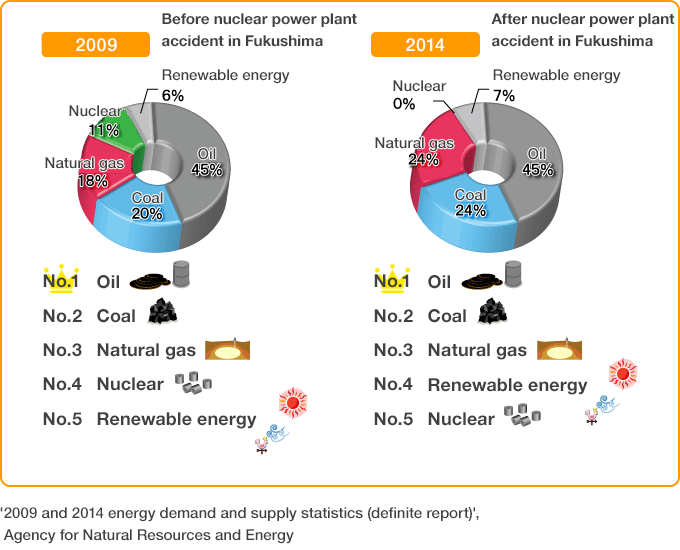
Japan is a resource-poor nation, therefore much of the energy needs to be imported.
Energy is obtained by mining; drilling the ground surface or several thousand meters of stratum under land or ocean. Energy is carried to Japan from worldwide across ocean by specialized vessels.
Shipment to Japan
As for energy transportation, Japan bears continuous risk in terms of energy security, in particular, disruption of energy supply to Japan due to the political situation in nations such as Middle East or a part of Asia, which are supplying energy or offering transportation paths to Japan.
It is crucial for Japan to diversify the suppliers, to increase self-sufficiency rate or to ensure energy security for the stable energy procurement.
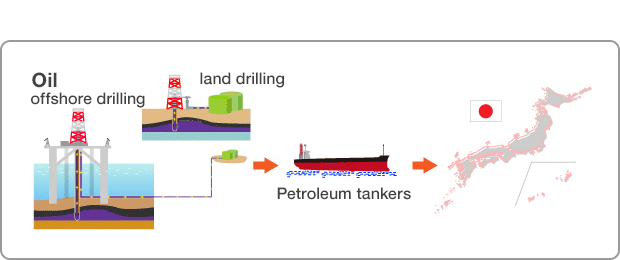
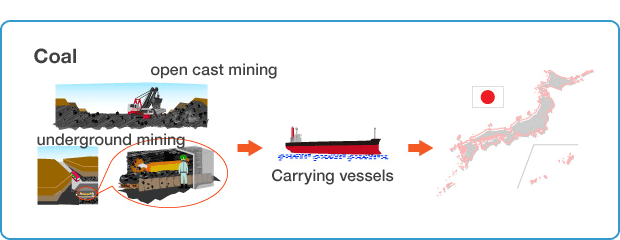
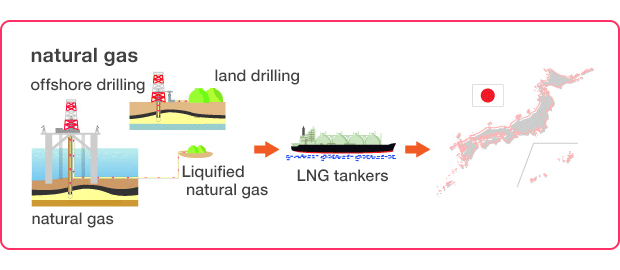
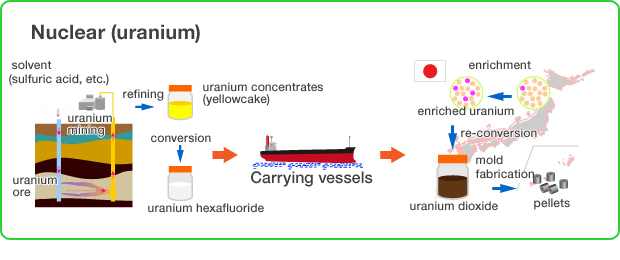
TOP5 countries in energy resources production amount
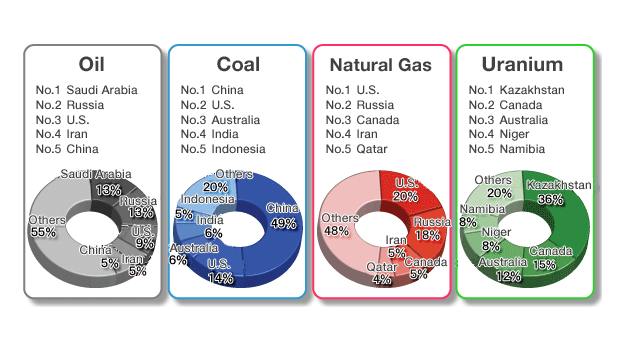
Source: Oil/Coal/Natural Gas: Prepared by RITE, based on BP Statistical Review of World Energy June 2012, accessed on June 6, 2013
Uranium: Prepared by RITE, based on World Nuclear Association (WNA), World Uranium Mining Production, accessed on June 7, 2013
* Coal includes anthracite, bituminous, sub-bituminous and lignite.
Amount of (exhaustible) resource energy
Exhaustible energy shall be exhaustible literally, but huge amount are still said to be left.
Definitions of amount of resources left are, in descending order of their certainty, “reserves”(commercially recoverable amount), “resources”(amount found) and “additional occurrences”. Even in the assessment of “reserves” with highest certainty, evaluated value has been reviewed and modified according to the discovery of new oil fields or mines through a technology progress or field expansion of exploration, as well as the escalation of mining potential through technology innovation.
As for oil and gas, recent technology innovation has contributed to the mining of shale oil and shale gas, allowing us to utilize those energies with lower cost, thus have led to the reexamination of reserves and resources.
| Historical production through 2005 (EJ) |
Production in 2005 (EJ) |
Reserves (EJ) |
Resources (EJ) |
Additional Occurrences (EJ) |
|
|---|---|---|---|---|---|
| Conventional oil | 6,069 | 147.9 | 4,900-7,610 | 4,170-6,150 | |
| Unconventional oil (oil sand, shale oil) |
513 | 20.2 | 3,750-5,600 | 11,280-14,800 | 40,000 |
| Conventional gas | 3,087 | 89.8 | 5,000-7,100 | 7,200-8,900 | |
| Unconventional gas (shale gas, tight gas) |
113 | 9.6 | 20,100-67,100 | 40,200-121,900 | > 1,000,000 |
| Coal (including lignite) |
6,712 | 123.8 | 17,300-21,000 | 291,000-435,000 | |
| Conventional uranium | 1,218 | 24.7 | 2,400 | 7,400 | |
| Unconventional uranium (including uranium dissolved in seawater) |
― | ― | ― | 4,100 | > 2,600,000 |
Source:Global Energy Assessment, 2012
CO2 emission coefficients of fossil energy
It is also important to know that fossil fuel combustion emits CO2, which is identified as a cause of global warming.
Out of coal, oil(crude) and gas, the largest CO2 emitter per unit is a coal combustion.
| CO2 emission coefficients Gg-CO2/1010 kcal |
|
|---|---|
| Coal (import) | 3.7927 |
| Oil | 2.8641 |
| Natural gas (import LNG) | 2.0675 |
Source:Ministry of the Environment








